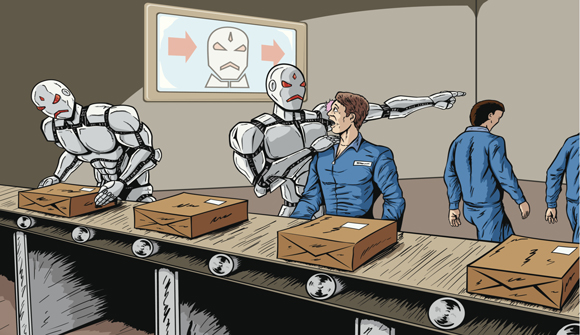
Another day, another bloodcurdling report about how robots are going to steal all our jobs and smash all that is holy about the dignity of work. This time it’s from PriceWaterhouseCoopers, and they tell us that by the 2040s some 30 percent of jobs will be automated, perhaps 44 percent for those requiring a low level of education. Actually, the report isn’t quite as “woe is unto us” as it sounds, although it does contain a couple of crucial errors.
What the authors get right is that there will be economic growth over this time, which will help create new jobs to replace the ones lost to automation. It’s a logical conclusion; after all, we’ve been doing this automation of heft and grunt for 250 years now and there’s no particular reason to think that the underlying processes have changed.
The fact artificial intelligence and other technical advances will replace human skill should not be a cause for dismay—after all, the same has been true of every stage of technological change from the loom to the washing machine.
That automation destroys or displaces jobs is not an error or problem; it’s the whole point.
However, the PWC report has misidentified the mechanism here. It’s not that economic growth absorbs labor, per se. It is the way automation frees up previous working hours for more productive uses which grow the economy and make us richer.
Imagine it takes 100 units of labor to make 100 widgets until a new machine now means we need 50 units to make 100 widgets. We can, with that labor, now have 200 widgets—we’re richer—or we can have 100 widgets and 50 units of labor’s worth of clothes, fancy food, or tickets to the ballet. We’re richer, the economy is larger, by whatever value we place upon the extra things we can buy.
This is more than mere nitpicking. It is only by grasping this that we can understand our task here. That automation destroys or displaces jobs is not an error or problem; it’s the whole point. We want to kill jobs with automation, always and everywhere, as it is what that newly freed labor does next which makes us richer.
As Keynes noted, it’s entirely possible for this to be happening too quickly. Writing in 1930 he tells us:
We are suffering, not from the rheumatics of old age, but from the growing-pains of over-rapid changes, from the painfulness of readjustment between one economic period and another. The increase of technical efficiency has been taking place faster than we can deal with the problem of labor absorption…
In this case, the twin assault on established systems of the mechanization of agriculture and the replacement of steam by electrical power was freeing up labor faster than people could work out how to use it to do new things.
Transition can certainly be a problem, but our end state isn’t going to be. The question is not whether there will be anything for people to do, it’s can we find new things for them to do at the same rate as the old things are dying out.
The rate is what matters. In common with many other such reports, PWC’s report suggests 30 percent of jobs (or 44 percent in some sectors) will be killed off in the next few decades. Is that a high rate or not? Is it even something we need to do anything about?
Here’s the key point that many people fail to grasp—the UK’s market economy (the US numbers are little different) kills off some 10 percent or more of jobs each year as it is, and creates some 10 percent of jobs anew. The unemployment rate is only ever the mismatch between the two, perhaps the timing difference between them.
What we are really looking at is a marginal addition to a well-known process, not some step change nor gross unknown to deal with.
Our adaptation to shifting technology is not a dramatic rupture, but a constant process involving some 10 percent of the population each year. With that in mind, the addition of another 1.5 percent (30 percent over two decades) or so due to automation becomes much less bloodcurdling. What we are really looking at is a marginal addition to an extant and well-known process, not some step change nor gross unknown to deal with. And that’s assuming that artificial intelligence is an addition to our usual annual rate of 10 percent, rather than just the 21st-century version of that well-worn process.
There is still the question of what we do about it, of course. What is automated and how isn’t the interesting thing here. Rather, it’s what will that newly liberated labor go and do—what are the jobs of the future?
While we can make some educated guesses, the answer is that we don’t know. There are plenty of things we as a species would like to do more of, but the only way to find out how that translates into economic activity is to leave people to suck it and see. Rather than governments trying to second-guess the future, we should rely on the experimentation which only a market economy provides.
This article was originally published on FEE.org. Read the original article.
